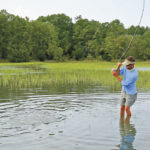
Catching redfish tailing up on a grassy marsh flat is a unique, exciting experience. Finding tailers is as easy as finding a “tailing flat.” Here’s how:
The No. 1 thing all tailing flats have in common is that they remain dry most of the time, exceptions being higher-than-average flood tides or spring tides. This allows them to have surfaces firm enough for anglers to walk on and keeps the spartina grass shorter and thinner than the surrounding marsh — making spotting and targeting redfish much easier.
Take a close look at the South Carolina coast on Google Earth, and countless numbers of these flats can be spotted; many others are visible from the highway, but not all of these flats will draw in redfish. A few other key factors need to be met before redfish will visit with any frequency.
According to Capt. Owen Plair of Bay Street Outfitters in Beaufort, “When looking for a tailing flat, you have to compare it to a big puzzle, because there are a lot of pieces that have to come together to create a good tailing redfish flat.”
Plair likes to walk and check out a flat before deciding whether it will be good one. The first thing he looks for is f fiddler crabs. “Crabs make up a large portion of a redfish’s diet, and they are the main reason the redfish come on the flat,” he said. During the colder months, crabs are not very active on the flats, and redfish are much less likely to be found tailing there; they will start showing up on the tailing tides as early as April and will frequent them into November, with late summer through fall the best times.
One of the most important aspects of a tailing flat is how easily reds can access it. Small inlet creeks are the highways that reds use to enter a flat, and the more creeks the better. These creeks are easily visible when looking at satellite imagery, but they also can be spotted from land, and as the tide comes in, reds can often be seen working their way through the thick stuff. “The best way to find an entry point is to look for taller green grass in the shape of a small creek,” Plair said.
After all of the basic criteria have been met, it is just a matter of trial-and-error to find out whether the flat will be productive, because even the best flats may have days when the reds do not show. Basically, if reds can be found in the main body of water than they should also come up on the flat at some point and time.
The height of tide needed to flood a tailing flat depends on the area targeted. Generally, anglers from the Beaufort and Hilton Head areas will use the tide levels at the Savannah River entrance as a guide, and anglers from Charleston up to the flats of Cape Romain will use the tide levels at Charleston Harbor as their guide. According to Capt. Ben Alderman of Charleston, the ideal tide range is 5.5 to around 6.2 feet, but he said, “It is all about the amount and direction of the wind.”
A strong easterly wind can easily add several inches to what is being predicted; the opposite is true on a day with a westerly wind. The wind also affects the tidal level around Beaufort, but the minimum prediction Plair prefers on a calm day is in the mid-7s, with the maximum around the low 8s. On days with bigger-than-preferred tides with little or no wind and clear skies Alderman will still fish the flats.
“It is still possible to see the fish cruising when the conditions are right, but if it is cloudy or the wind is affecting visibility,” he said. “It can be very difficult to spot fish except for the early part of the tide when the tails are visible.”
Both Plair and Alderman like to step on a flat two hours before the peak at that location. This gives them time to get in position on the flat and catch fish as they start to come in. Generally, the first fish will show at around 1-1/2 hours before peak, and the last fish will leave about the same amount of time afterwords, depending on the height of the tide.
Finding a good tailing flat can seem like guesswork for many anglers, but by learning what features to look for and when to fish them can greatly increase their chances of finding productive flats and hooking up with tailing reds.






Be the first to comment